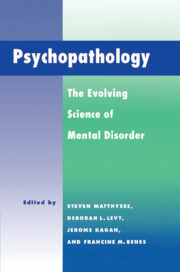Book contents
- Frontmatter
- Contents
- List of Contributors
- Preface
- Brain mechanisms
- Development
- Thinking
- Genetics
- 20 Editors' introduction: Contemporary issues in the genetics of psychopathological disorders
- 21 Genetic and environmental factors in the etiology of schizophrenia
- 22 Problems and paradoxes in research on the etiology of schizophrenia
- Comments on Einar Kringlen's chapter
- 23 Epistemological issues in psychiatric research
- 24 Searching for major genes for schizophrenia
- 25 The Drosophila eye and the genetics of schizophrenia
- Response and reflections
- Author index
- Subject index
Comments on Einar Kringlen's chapter
Published online by Cambridge University Press: 04 May 2010
- Frontmatter
- Contents
- List of Contributors
- Preface
- Brain mechanisms
- Development
- Thinking
- Genetics
- 20 Editors' introduction: Contemporary issues in the genetics of psychopathological disorders
- 21 Genetic and environmental factors in the etiology of schizophrenia
- 22 Problems and paradoxes in research on the etiology of schizophrenia
- Comments on Einar Kringlen's chapter
- 23 Epistemological issues in psychiatric research
- 24 Searching for major genes for schizophrenia
- 25 The Drosophila eye and the genetics of schizophrenia
- Response and reflections
- Author index
- Subject index
Summary
The ratio of monozygotic to dizygotic twin concordances (MZ/DZ) has been used, as Professor Kringlen indicates, as a way of defining the phenotype of schizophrenia (see also Introduction to the Genetics section). Essentially, the idea is that whatever definition has the highest MZ/DZ ratio is the “most genetic.” One can also look at the MZ/DZ ratio in a different light. Polygenic or oligogenic factors tend to elevate the MZ/DZ ratio, whereas it is expected to be close to 2 for a dominant trait caused by a single gene [2, 3]. It may be that, if a certain phenotypic definition of schizophrenia yields an MZ/DZ ratio close to 2, that phenotype is most plausibly attributed to a single gene. Other phenotypic definitions with higher MZ/DZ ratios would perhaps be associated with multigenic or polygenic factors. An analysis of this kind requires that the probands be diagnosed with the same criteria, broad or narrow, that are used for the co-twins.
The study of Farmer et al. [1] provides data that may be interpreted in this way. Rediagnosing the 62 probands from the Maudsley series according to DSM-III criteria, Farmer et al. found an MZ/DZ ratio of 5.01 for schizophrenia, consistent with the action of multiple genes, but the ratio decreased progressively as the criteria were broadened, reaching a value of 3.23 when schizophreniform disorder, paranoia and schizoaffective disorder were included.
- Type
- Chapter
- Information
- PsychopathologyThe Evolving Science of Mental Disorder, pp. 509 - 510Publisher: Cambridge University PressPrint publication year: 1996



